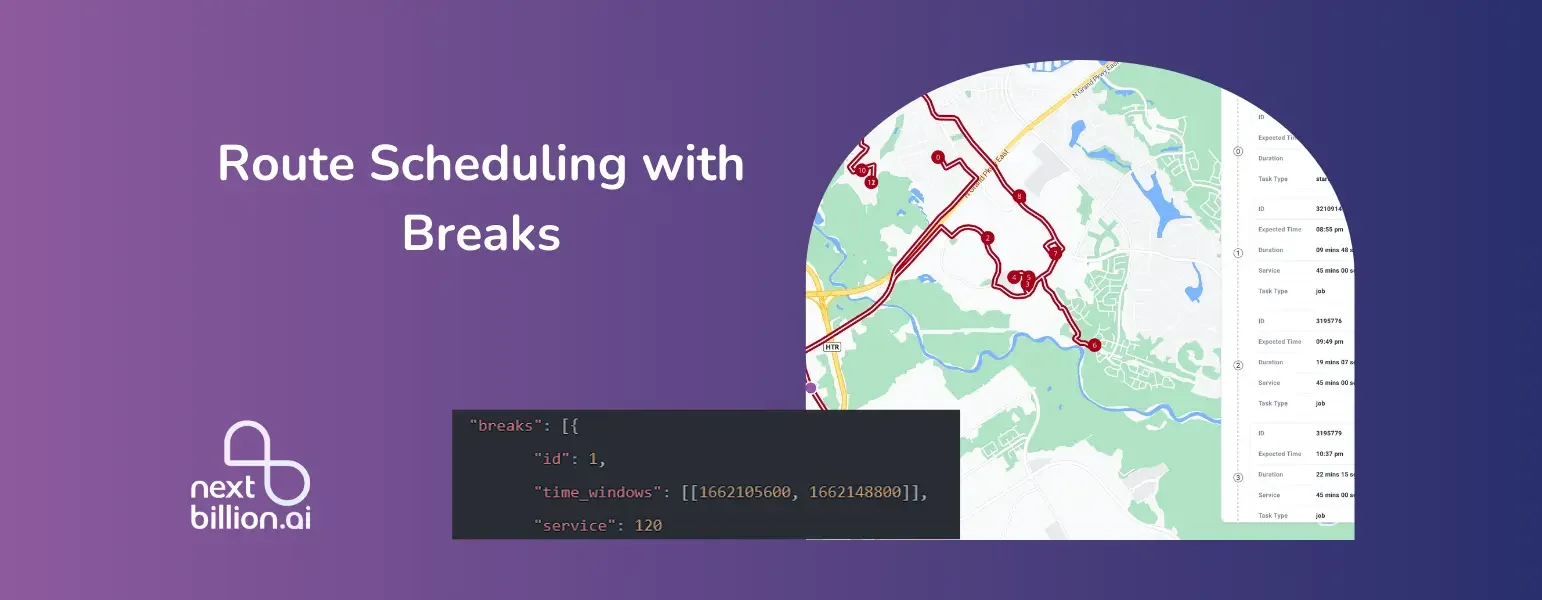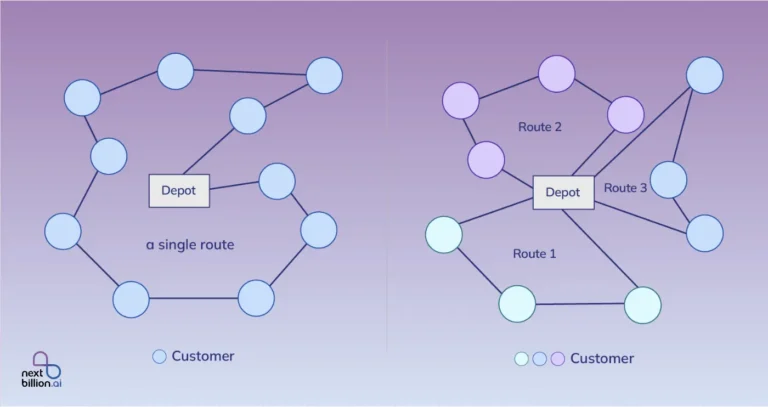
Table of Contents
Table of Contents
In 2024, the logistics industry is dealing with an urgent need to enhance efficiency and prioritize driver well-being. Consequently, route scheduling with breaks has emerged as an important topic of discussion. Including breaks into route planning goes beyond simply following regulations.
It involves optimizing operations and prioritizing safety. Using a well-planned route schedule with strategic breaks can significantly decrease accidents caused by fatigue, boost delivery punctuality, and ultimately enhance productivity.
Challenges in Scheduling Routes with Breaks
A. Regulatory Compliance
Overview of Relevant Regulations
Regulatory compliance is a major challenge in route scheduling, particularly with respect to break requirements. In the U.S., the Federal Motor Carrier Safety Administration (FMCSA) enforces Hours of Service (HOS) rules, which dictate the maximum driving hours and mandatory rest periods for commercial drivers. For instance, drivers are required to take a 30-minute break after 8 hours of driving. These regulations are designed to prevent driver fatigue and ensure road safety.
Penalties for Non-Compliance
Failure to adhere to these regulations can result in severe penalties, including hefty fines and operational shutdowns. Non-compliance can also lead to increased scrutiny from regulatory bodies, damaging a company’s reputation and customer trust. Ensuring that routes are scheduled with breaks that meet these regulatory requirements is crucial for avoiding these costly penalties.
B. Operational Constraints
Time-Sensitive Deliveries
Logistics companies often deal with time-sensitive deliveries that leave little room for deviations. Scheduling breaks while ensuring timely delivery of perishable goods, medical supplies, or urgent packages can be a significant challenge. Any delay in these deliveries can lead to customer dissatisfaction and potential loss of business.
Limited Flexibility in Schedules
Many logistics operations operate on tight schedules with minimal flexibility. Coordinating breaks within these rigid schedules can be complex, especially when dealing with multiple stops and varying delivery windows. Limited flexibility can make it difficult to incorporate the necessary breaks without disrupting the overall schedule.
C. Optimization Complexity
Balancing Route Efficiency with Break Requirements
Achieving the optimal balance between route efficiency and mandatory break requirements is a complex task. Scheduling breaks in a way that minimizes travel time and fuel consumption while still adhering to regulations requires sophisticated route optimization algorithms. These algorithms must account for multiple variables, including traffic patterns, delivery windows, and driver availability.
Impact on Overall Logistics and Delivery Times
Incorporating breaks into route planning can impact overall logistics and delivery times. Breaks can extend the total travel time, affecting the efficiency of the entire logistics network. Finding the right balance between maintaining regulatory compliance and optimizing delivery schedules is a delicate task that requires careful planning and constant adjustment.
By understanding and addressing these challenges, logistics companies can develop more effective strategies for route scheduling with breaks, ensuring regulatory compliance, operational efficiency, and high customer satisfaction.
How to Include Breaks while Route Planning in 2024?
NextBillion.ai simplifies operations for location-driven businesses with an API-first platform that prioritizes ease of use, customization, and seamless integration. By leveraging advanced technologies, NextBillion.ai provides innovative solutions for optimizing delivery routes, ensuring efficiency, and reducing operational costs.
Route Optimization API
NextBillion.ai’s Route Optimization API is a powerful tool designed to help businesses optimize their delivery routes. This API addresses both Single and Multi-Vehicle Routing Problems (VRP), classic optimization challenges in operations research. It involves finding the most efficient routes for a fleet of vehicles to visit a set of locations while satisfying various constraints such as time windows, capacity, and vehicle availability.
The Route Optimization API consists of two main components: the input data and the optimization engine. The input data includes information about jobs (stops/places to visit), vehicles (delivery trucks, vans, etc.), and shipments (pickup and delivery tasks).
The optimization engine uses this data to find the most efficient set of routes for the vehicles to follow. With the ability to handle complex constraints and variables, this API can be customized to meet the specific needs of any business.
NextBillion.ai’s ‘Breaks’ Parameter in Route Optimization API
One of the standout features of NextBillion.ai’s Route Optimization API is the ‘breaks’ parameter. This parameter is essential for incorporating mandatory breaks into route planning, ensuring compliance with regulations and promoting driver safety.
Break Attribute
The break attribute provides details of the break that a driver can take during their route. Note that only one break object is allowed per vehicle, but multiple time windows can be specified for when the break can be taken.
id (integer, required): Specify an ID for the break. It should be a positive integer.
Example: “id”: 5
time_windows (array[array], required): Describe the possible time periods for the driver to take a break. The time periods should be expressed as UNIX timestamps in seconds.
Example: [[1656487800, 1656516600]]
description (string): Add a custom description for the break.
Example: “description”: “Lunch”
service (integer): Specify the break duration in seconds.
Example: “service”: 900
The following cURL command showcases an API request example of how to include breaks in route scheduling.
curl --location 'https://api.nextbillion.io/optimization/v2?key=' \
--header 'Content-Type: application/json' \
--data '{
"description": "Vehicle Break Example",
"locations": {
"id": 1,
"location": ["34.05083235,-118.24521687","33.90281344,-118.29257583","33.96813794,-118.31970938","34.08371352,-118.34309018","34.95447679,-120.43341196"]
},
"jobs": [
{
"id": "Delivery 1",
"location_index": 1,
"service": 300,
"delivery": [
5
],
"time_windows":[[1721646000, 1721646900]]
},
{
"id": "Delivery 2",
"location_index": 2,
"service": 300,
"delivery": [
3
],
"time_windows":[[1721647500, 1721647800]]
},
{
"id": "Delivery 3",
"location_index": 3,
"service": 300,
"delivery": [
3
],
"time_windows":[[1721649600, 1721650200]]
},
{
"id": "Delivery 4",
"location_index": 4,
"service": 300,
"delivery": [
5
],
"time_windows":[[1721660400, 1721662200]]
}
],
"vehicles": [
{
"id": 1,
"start_index": 0,
"capacity": [
25
],
"time_window":[1721644200, 1721664000],
"break":{
"id":1,
"time_windows":[
[1721651400, 1721653500],
[1721657400, 1721659500]
],
"description":"Lunch Break",
"service": 1800
}
}
]
}'
The API returns the following response.
{
"id": "9383baaa3c212e93c22129c4244f0acc",
"message": "Optimization job created",
"status": "Ok",
"warning": [
"location_index[6] and 10 others are unused"
]
}How This Parameter Helps Businesses in Logistics?
The ‘breaks’ parameter in NextBillion.ai’s Route Optimization API provides several benefits for logistics businesses:
Regulatory Compliance: Ensures that routes are planned with mandatory breaks, helping businesses comply with Hours of Service (HOS) regulations and avoid penalties.
Driver Safety and Well-being: Incorporates breaks to prevent driver fatigue, enhancing safety and reducing the risk of accidents.
Operational Efficiency: Allows for strategic scheduling of breaks within the route, minimizing disruptions and ensuring timely deliveries.
Customization: Offers flexibility to specify multiple time windows for breaks, accommodating various operational needs and constraints.
Cost Reduction: Optimizes routes to balance efficiency and regulatory compliance, leading to cost savings in fuel and operational expenses.
By integrating the ‘breaks’ parameter, NextBillion.ai’s Route Optimization API empowers logistics businesses to create more efficient, compliant, and safe delivery routes, driving overall success in their operations.
Importance of Breaks in Route Scheduling
Legal and Safety Requirements
Integrating breaks into route scheduling is essential to ensure that you meet legal and safety regulations. Regulations, such as the Hours of Service (HOS) rules in the U.S., enforce designated rest periods for drivers in order to reduce the risk of accidents caused by fatigue. Sticking to these regulations not only helps you avoid costly fines and penalties but also promotes safer driving practices, minimizing the chances of accidents and improving overall road safety.
Benefits for Driver Well-being and Productivity
It is crucial to prioritize breaks in order to ensure the well-being and productivity of drivers. Taking regular breaks is crucial in preventing fatigue, which in turn reduces the chances of making mistakes or getting involved in accidents.
Drivers who are well-rested exhibit heightened alertness and concentration, resulting in enhanced driving safety and efficiency. Including scheduled breaks into the workday has been shown to have a positive impact on job satisfaction and morale. This, in turn, can lead to increased productivity and lower turnover rates.
Incorporating regular breaks into route planning is crucial for promoting the well-being, safety, and motivation of drivers, which in turn has a positive impact on the overall efficiency of the logistics operation.
Getting Started with Breaks in Route Scheduling
To implement breaks in your route scheduling, consider utilizing NextBillion.ai’s Route Optimization API. This powerful tool allows you to efficiently plan routes while integrating mandatory breaks to ensure compliance and enhance driver well-being. By customizing the API to meet your specific needs, you can optimize your logistics operations and improve overall productivity.
Ready to streamline your route scheduling with breaks?
Contact NextBillion.ai today and see how our solutions can transform your logistics management.
About Author
Rishabh Singh
Rishabh Singh is a Freelance Technical Writer at NextBillion.ai. He specializes in Programming, Data analytics and technical consulting, turning complex tech into clear and engaging content.







